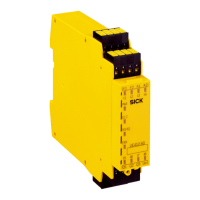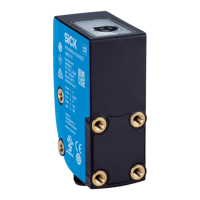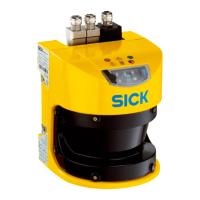•
Use t
he same earthing method for all devices that are electrically connected to the
safety laser scanner.
•
Voltage supply must be supplied in accordance with SELV/PELV (IEC 60204-1) for
all devices that are electrically connected to the safety laser scanner.
4.4.2 USB connection
The safety laser scanner has a USB connection for configuration and diagnostics. The
U
SB connection complies with the USB 2.0 mini-B standard (female connector). The
USB connection may only be used temporarily and only for configuration and diagnos‐
tics. More information: see "Configuration", page 74 and see "Troubleshooting",
page 135.
4.4.3 Control inputs
The safety laser scanner can accept signals for switching between monitoring cases via
t
he network.
The assembly represents locally connected static control inputs.
When switching between monitoring cases, bear in mind that a person may already be
in the protective field when switching takes place. So, you must make sure that the
monitoring case is switched at the right time. Only switching in time (namely before the
danger arises for the person at this location) ensures protection, see "Monitoring case
switching time", page 32.
4.4.3.1 Static control inputs
The static control inputs represented in the assembly support the following evaluation
me
thods:
•
Complementary analysis
•
1-of-n-evaluation
You can define the switching criteria for the monitoring cases (see "Monitoring cases",
page 105).
Complementary analysis
A s
tatic control input consists of 2 channels. To switch correctly, one channel must be
switched inversely to the other. The following table shows which status the static control
input’s channels must have to define logical input condition 1 and 0 at the relevant
control input.
Table 4: Status of the channels of the control inputs with complementary evaluation
A1 A2 Logical input status (input A)
1 0 0
0 1 1
1 1 Fault
0 0 Fault
In antivalent evaluation, the 2 channels of each static control input must always be
in
verted, even if the status of a control input in a monitoring case is random. If it is not
inverted, all safety outputs switch to the OFF state and the device displays a fault.
1-of-n-evaluation
In the 1-off-n-evaluation, use the channels of the control inputs represented in the
assembly individually.
4 P
ROJECT PLANNING
54
O P E R A T I N G I N S T R U C T I O N S | microScan3 – EFI-pro 8021913/15ZW/2019-11-14 | SICK
Subject to change without notice

